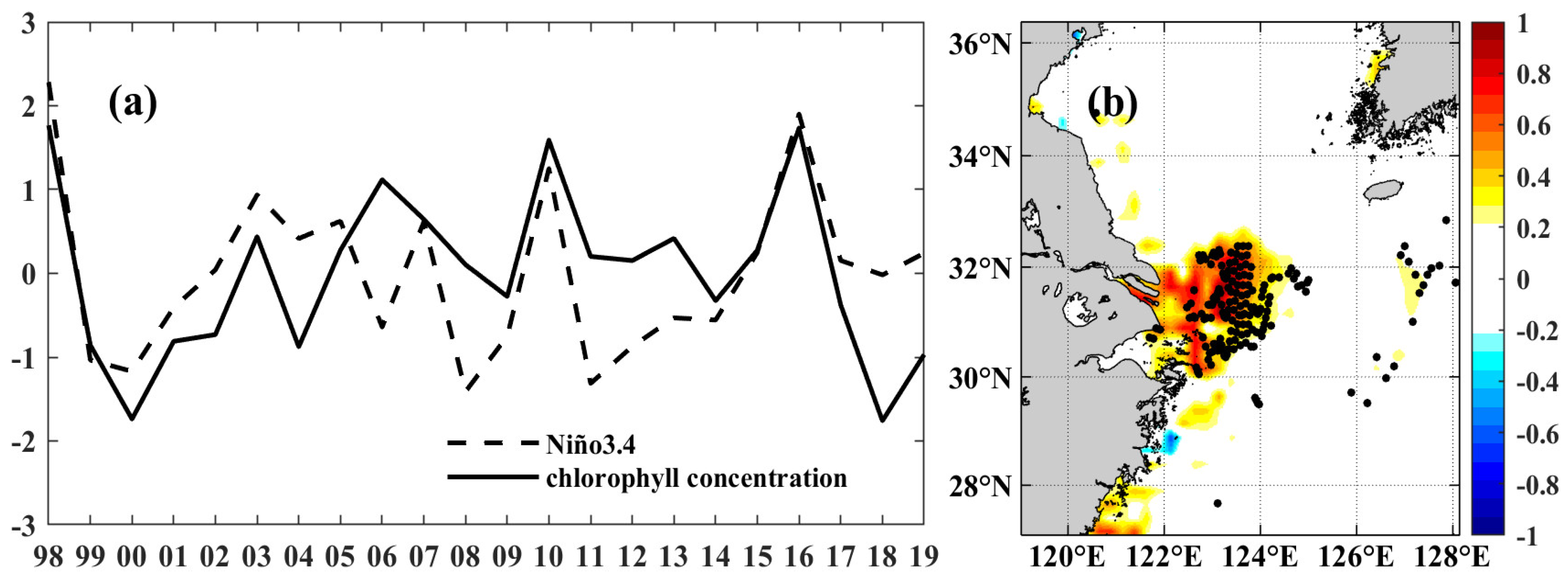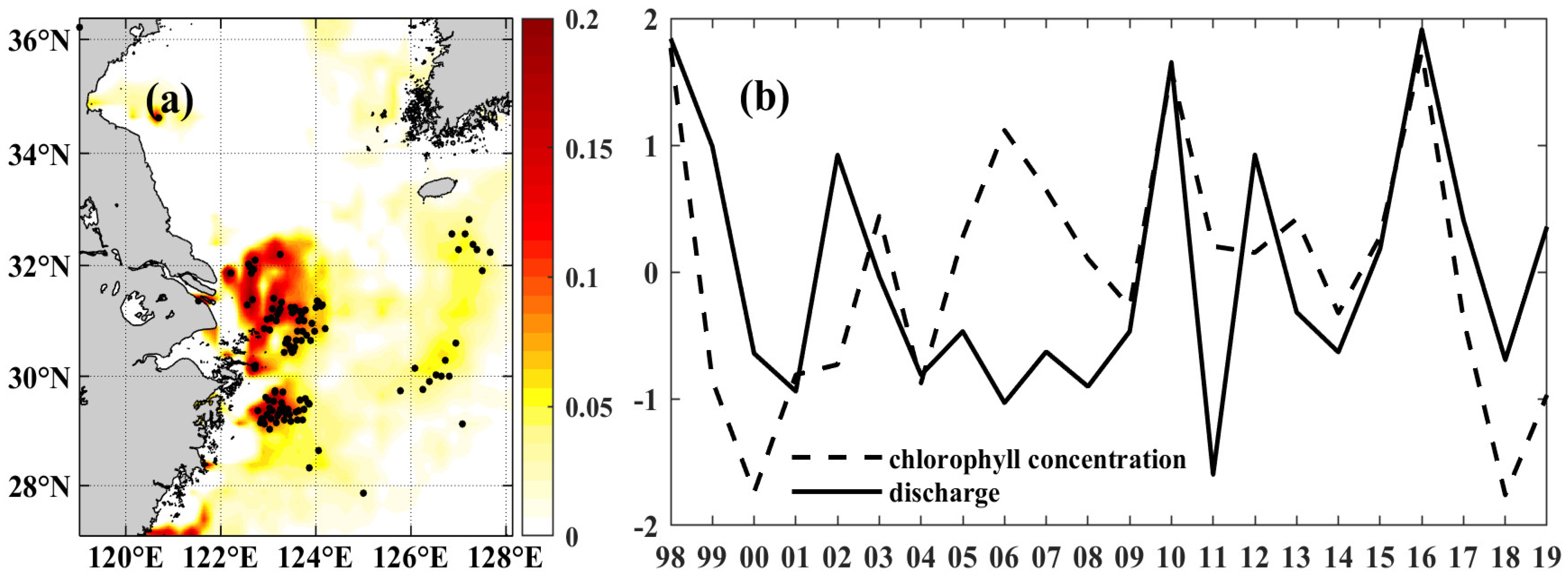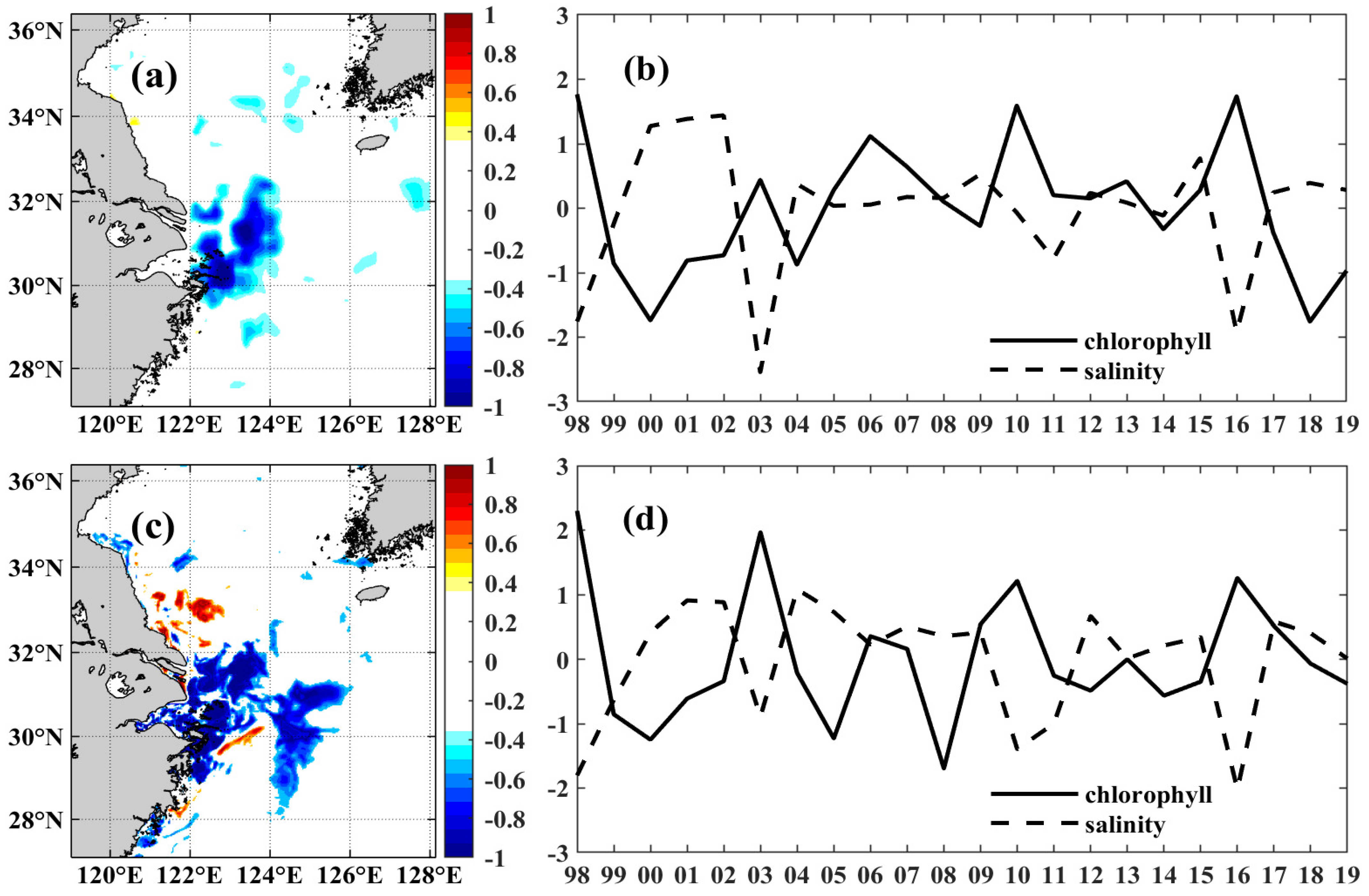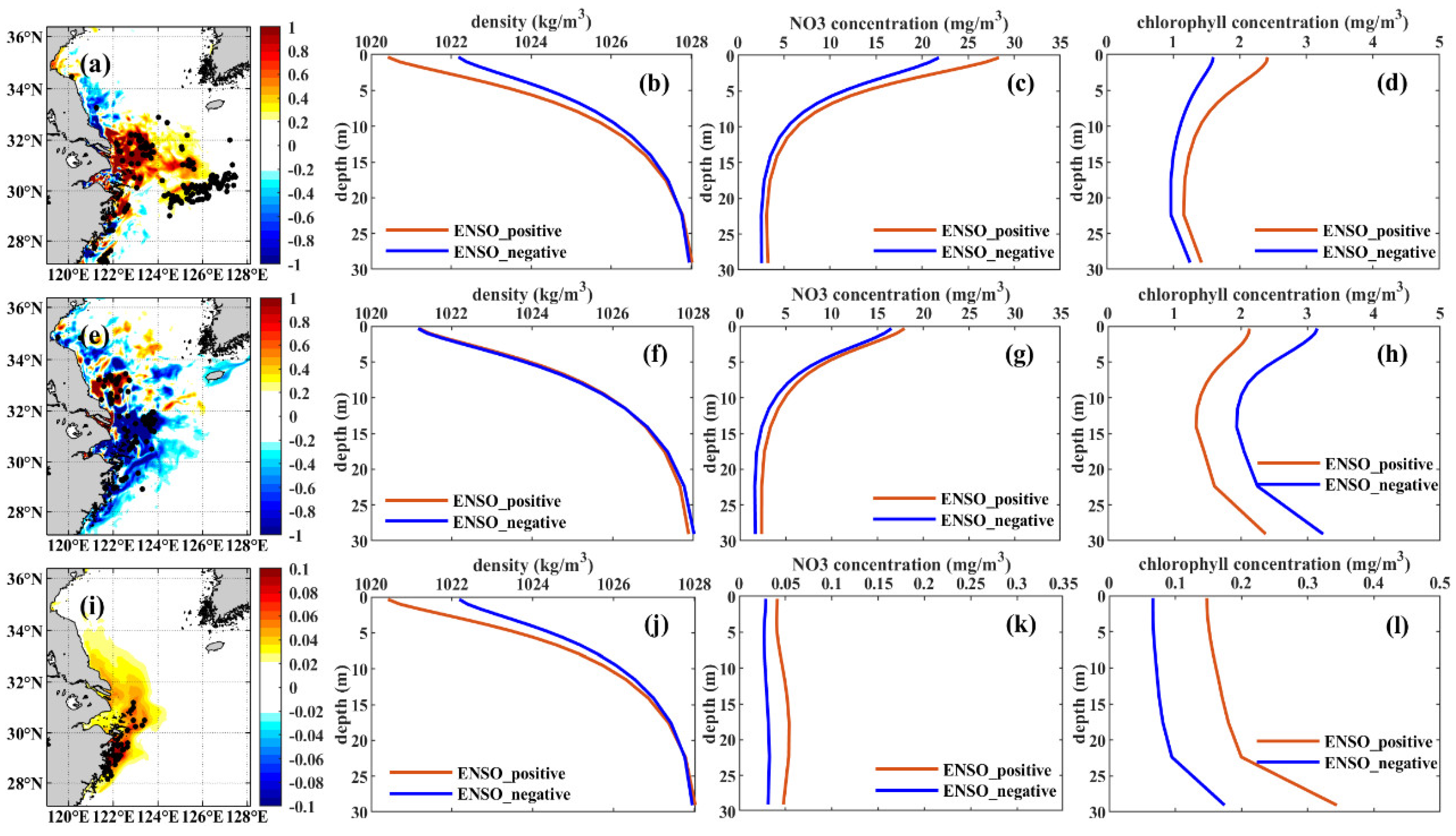The Relationship between Chlorophyll Concentration and ENSO Events and Possible Mechanisms off the Changjiang River Estuary
Abstract
:1. Introduction
2. Materials and Methods
2.1. Model
2.2. Initial Condition and the Forcing Fields
2.3. Numerical Experiment Design
3. Results
3.1. Interannual Variation of Chlorophyll Concentration off the Changjiang Estuary
3.2. Possible Physical Mechanisms
4. Model Results
4.1. Validation of Model Simulation
4.2. The Influence of Discharge and Nutrients on Chlorophyll Concentration
5. Discussions and Conclusions
Author Contributions
Funding
Data Availability Statement
Acknowledgments
Conflicts of Interest
References
- Zhang, J.; Liu, S.M.; Ren, J.L. Nutrients gradients from the eutrophic Changjiang (Yangtze River) estuary to the oligotrophic Kuroshio Waters and re-evaluation of budgets for the East China Sea shelf. Prog. Oceanogr. 2007, 74, 449–478. [Google Scholar] [CrossRef]
- Liu, K.K.; Gong, G.C.; Wu, C.R. The Kuroshio and the East China Sea. In Carbon and Nutrients Fluxes in Continental Margins: A Global Synthesis; Liu, K.K., Atkinson, L., Quiñones, R., Talaue-McManus, L., Eds.; IGBP Book Series; Springer: Berlin/Heidelberg, Germany, 2010; pp. 124–146. [Google Scholar]
- Zhang, J. Nutrients elements in large Chinese estuaries. Cont. Shelf Res. 1996, 16, 1023–1045. [Google Scholar] [CrossRef]
- Liu, X.C.; Shen, H.T.; Huang, Q.H. Concentration variation and flux estimation of dissolved inorganic nutrients from the Changjiang River into its estuary. Oceanol. Limnol. Sin. 2002, 33, 332–340. Available online: https://en.cnki.com.cn/Article_en/CJFDTOTAL-HYFZ200203013.htm (accessed on 2 January 2023).
- Shen, Z.L.; Liu, Q. Nutrients in the Changjiang River. Environ. Monit Assess 2009, 153, 27–44. [Google Scholar] [CrossRef]
- Chai, C.; Yu, Z.M.; Shen, Z.L. Nutrients characteristics in the Yangtze River Estuary and the adjacent East China Sea before and after impoundment of the Three Gorges Dam. Sci. Total Environ. 2009, 407, 4687–4695. [Google Scholar] [CrossRef] [PubMed]
- Domingues, R.B.; Barbosa, A.; Galvão, H. Nutrients, light and phytoplankton succession in a temperate estuary (the Guadiana, south-western Iberia) Estuarine. Estuar. Coast. Shelf Sci. 2005, 64, 249–260. [Google Scholar] [CrossRef]
- Furnas, M.; Mitchell, A.; Skuza, M. In the other 90%: Phytoplankton responses to enhanced nutrients availability in the Great Barrier Reef Lagoon. Mar. Pollut. Bull. 2005, 51, 253–265. [Google Scholar] [CrossRef] [PubMed]
- Paerl, H.W. Assessing and managing nutrients-enhanced eutrophication in estuarine and coastal waters: Interactive effects of human and climatic perturbations. Ecol. Eng. 2006, 26, 40–54. [Google Scholar] [CrossRef]
- Gong, G.C.; Liu, K.K.; Pai, S.C. Prediction of nitrate concentration from two end member mixing in the southern East China Sea. Cont. Shelf Res. 1995, 15, 827–842. [Google Scholar] [CrossRef]
- Chen Lee, Y.L.; Chen, H.Y.; Gong, G.C. Phytoplankton production during a summer coastal upwelling in the East China Sea. Cont. Shelf Res. 2004, 24, 1321–1338. [Google Scholar] [CrossRef]
- Wang, Y.; Jiang, H.; Jin, J.X. Spatial-Temporal Variations of Chlorophyll in the Adjacent Sea Area of the Yangtze River Estuary Influenced by Yangtze River Discharge. Int. J. Environ. Res. Public Health 2015, 12, 5420–5438. [Google Scholar] [CrossRef] [PubMed]
- Zhou, M.J.; Yan, T.; Zou, J.Z. Preliminary analysis of the characteristics of red tide areas in Changjiang River Estuary and its adjacent sea. Chin. J. Appl. Ecol. 2003, 14, 1031–1038. Available online: https://pubmed.ncbi.nlm.nih.gov/14587317/ (accessed on 1 January 2023).
- Zhou, M.J.; Zhu, M.Y. Progress of the project “Ecology and oceanography of harmful algal blooms in China”. Adv. Earth Sci. 2006, 21, 673–679. [Google Scholar]
- Zhou, M.J.; Shen, Z.L.; Yu, R.C. Responses of a coastal phytoplankton community to increased nutrients input from the Changjiang (Yangtze) River. Cont. Shelf Res. 2008, 28, 1483–1489. [Google Scholar] [CrossRef]
- Hu, D.X. Some striking features of circulation in Huanghai Sea and East China Sea. Oceanol. China Seas 1994, 11, 27–28. [Google Scholar] [CrossRef]
- Isobe, A.; Ando, M.; Watanabe, T. Freshwater and temperature transports through the Tsushima–Korea Straits. J. Geophys. Res. 2002, 107, 3065. [Google Scholar] [CrossRef]
- Lie, H.J.; Cho, C.H.; Lee, J.H. Structure and eastward extension of the Changjiang River plume in the East China Sea. J. Geophys. Res. 2003, 108, 3077. [Google Scholar] [CrossRef]
- Liu, X.Y.; Liu, Y.G.; Guo, L. Interannual changes of sea level in the two regions of East China Sea and different responses to ENSO. Global Planet. Change 2010, 72, 215–226. [Google Scholar] [CrossRef]
- Park, T.; Jang, C.J.; Kwon, M. An effect of ENSO on summer surface salinity in the Yellow and East China seas. J. Mar. Syst. 2015, 141, 122–127. [Google Scholar] [CrossRef]
- Gong, G.G.; Wen, Y.H.; Wang, B.W. Seasonal variation of chlorophyll a concentration, primary production and environmental conditions in the subtropical East China Sea. Deep. Sea Res. Part II Top. Stud. Oceanogr. 2003, 50, 1219–1236. [Google Scholar] [CrossRef]
- He, X.Q.; Bai, Y.; Pan, D.L. Satellite views of the seasonal and interannual variability of phytoplankton blooms in the eastern China seas over the past 14 yr (1998–2011). Biogeosciences 2013, 10, 4721–4739. [Google Scholar] [CrossRef]
- Hallegraeff, G.M. Ocean climate change, phytoplankton community responses, and harmful algal blooms: A formidable predictive challenge. J. Phycol. 2010, 46, 220–235. [Google Scholar] [CrossRef]
- Stramska, M. Interannual variability of seasonal phytoplankton blooms in the north polar Atlantic in response to atmospheric forcing. J. Geophys. Res. C Oceans 2005, 110, C05016-1. [Google Scholar] [CrossRef]
- Chai, F.; Lindley, S.T.; Barber, R.T. Origin and maintenance of a high NO3 condition in the equatorial Pacific. Deep. Sea Res. Part II Top. Stud. Oceanogr. 1996, 43, 1031–1064. [Google Scholar] [CrossRef]
- Chai, F.; Dugdale, R.C.; Peng, T.H. One-dimensional ecosystem model of the equatorial Pacific upwelling system. Part I: Model development and silicon and nitrogen cycle. Deep. Sea Res. Part II Top. Stud. Oceanogr. 2002, 49, 2713–2745. [Google Scholar] [CrossRef]
- Xiu, P.; Chai, F. Modeled biogeochemical responses to mesoscale eddies in the South China. J. Geophys. Res. C Oceans 2011, 116, C10. [Google Scholar] [CrossRef]
- Xiu, P.; Chai, F. Spatial and temporal variability in phytoplankton carbon, chlorophyll, and nitrogen in the North Pacific. J. Geophys. Res. C Oceans 2012, 117, C11023. [Google Scholar] [CrossRef]
- Xiu, P.; Chai, F. Connections between physical, optical and biogeochemical processes in the Pacific Ocean. Prog. Oceanogr. 2014, 122, 30–53. [Google Scholar] [CrossRef]
- Zhou, F.; Chai, F.; Huang, D.J. Investigation of hypoxia off the Changjiang Estuary using a coupled model of ROMS-CoSiNE. Prog. Oceanogr. 2017, 159, 237–254. [Google Scholar] [CrossRef]
- Wu, Q.; Wang, X.C.; Xiu, P. Sensitivity of chlorophyll variability to specific growth rate of phytoplankton over the Yangtze River estuary in a physical-biogeochemical model. Atmosphere 2022, 13, 1748. [Google Scholar] [CrossRef]
- Garcia, H.E.; Locarnini, R.A.; Boyer, T.P. World Ocean Atlas 2005, Nutrients (Phosphate, Nitrate, Silicate); Government Printing Office: Washington, DC, USA, 2006; pp. 2–14. Available online: https://repository.library.noaa.gov/view/noaa/1129 (accessed on 1 January 2023).
- Kalnay, E.; Kanamitsu, M.; Kistler, R. The NCEP/NCAR 40-year reanalysis project. Bull. Am. Meteorol. Soc. 1996, 77, 437–471. [Google Scholar] [CrossRef]
- Kondo, J. Air-sea bulk transfer coefficients in diabatic conditions. Bound. Layer Meteorol. 1975, 9, 91–112. [Google Scholar] [CrossRef]
- Large, W.G.; Pond, S. Sensible and latent heat flux measurements over the ocean. J. Phys. Oceanogr. 1982, 12, 464–482. [Google Scholar] [CrossRef]
- Key, R.M.; Kozyr, A.; Sabine, C.L. A global ocean carbon climatology: Results from GLODAP. Global Biogeochem. Cycles 2004, 18, GB4031. [Google Scholar] [CrossRef]
- Cheng, L.J.; Trenberth, K.E.; Fasullo, J. Improved estimates of ocean heat content from 1960 to 2015. Sci. Adv. 2017, 3, e1601545. [Google Scholar] [CrossRef] [PubMed]
- Cheng, L.J.; Trenberth, K.E.; Gruber, N. Improved estimates of changes in upper ocean salinity and the hydrological cycle. J. Clim. 2020, 33, 10357–10381. [Google Scholar] [CrossRef]
- Luo, B.Z.; Liu, R.Y. Construction of Three Gorge Dam Project and the Ecology and Environment in the Estuary Science Press; Beijing Publication: Beijing, China, 1994; p. 343. [Google Scholar]
- Berdeal, I.B.; Hickey, B.M.; Kawase, M. Influence of wind stress and ambient flow on a high discharge river plume. J. Geophys. Res. C Oceans 2002, 107, 3130. [Google Scholar] [CrossRef]
- Jin, M.B.; Wang, J. Interannual variability and sensitivity study of the ocean circulation and thermohaline structure in Prince William Sound, Alaska. Cont. Shelf Res. 2004, 24, 393–411. [Google Scholar] [CrossRef]
- Mooers, C.N.K.; Wu, X.L.; Bang, I. Performance of a nowcast/forcast system for Prince William Sound, Alaska. Cont. Shelf Res. 2007, 29, 42–60. [Google Scholar] [CrossRef]
- Wang, X.C.; Chao, Y.; Zhang, H.C. Modeling tides and their influence on the circulation in Prince William Sound, Alaska. Cont. Shelf Res. 2013, 63, S126–S137. [Google Scholar] [CrossRef]
- Chang, P.H.; Isobe, A. A numerical study on the Changjiang diluted water in the Yellow and East China Seas. J. Geophys. Res. Oceans 2003, 108, C9. [Google Scholar] [CrossRef]
- Ye, S.F.; Ji, H.H.; Cao, L. Red tides in the Yangtze River Estuary and adjacent sea areas: Causes and mitigation. Mar. Sci. 2002, 28, 26–32. [Google Scholar]
- Chen, C.S.; Zhu, J.R.; Beardsley, R.C. Physical-biological sources for dense algal blooms near the Changjiang River. Geophys. Res. Lett. 2003, 30, 1515. [Google Scholar] [CrossRef]
- Gregg, W.W.; Casey, N.W.; McClain, C.R. Recent trends in global ocean chlorophyll. Geophys. Res. Lett. 2005, 32, L03606. [Google Scholar] [CrossRef]
- Ji, C.X.; Zhang, Y.Z.; Cheng, Q.M. Evaluating the impact of sea surface temperature (SST) on spatial distribution of chlorophyll-a concentration in the East China Sea. Int. J. Appl. Earth Obs. Geoinf. 2018, 68, 252–261. [Google Scholar] [CrossRef]
- Ware, D.M.; Thomson, R.E. Bottom-up ecosystem trophic dynamics determine fish production in the Northeast Pacific. Science 2005, 308, 1280–1284. [Google Scholar] [CrossRef]
- Jiang, T.; Zhang, Q.; Zhu, D.M. Yangtze floods and droughts (China) and teleconnections with ENSO activities (1470–2003). Quatern. Int. 2006, 144, 29–37. [Google Scholar] [CrossRef]
- Zhang, Q.; Yu, C.Y.; Jiang, T. Possible influences of ENSO on annual maximum streamflow of the Yangtze River, China. J. Hydrol. 2007, 333, 265–274. [Google Scholar] [CrossRef]
- Chen, J.; Wu, X.; Finlayson, B.L. Variability and trend in the hydrology of the Yangtze River, China: Annual precipitation and runoff. J. Hydrol. 2014, 513, 403–412. [Google Scholar] [CrossRef]
- Wang, B.; Li, J.; He, Q. Variable and robust East Asian monsoon rainfall response to El Niño over the past 60 years (1957–2016). Adv. Atmos. Sci. 2017, 34, 1235–1248. [Google Scholar] [CrossRef]
- Li, T.; Wang, B.; Wu, B. Theories on Formation of an Anomalous Anticyclone in Western North Pacific during El Niño: A Review. J. Meteorol. Res. 2017, 31, 987–1006. [Google Scholar] [CrossRef]
- Shen, Z.L. A study on the relationships of the nutrients near the Changjiang river estuary with the flow of the Changjiang river water. Chin. J. Oceanol. Limnol. 1993, 11, 260–267. Available online: http://www.cnki.com.cn/Article/CJFDTotal-HYFW199303008.htm (accessed on 1 January 2023).
- Wang, K.; Chen, J.F.; Jin, H.Y. The four seasons nutrients distribution in Changjiang River Estuary and its adjacent East China Sea. J. Mar. Sci. 2011, 29, 18–35. Available online: http://en.cnki.com.cn/Article_en/CJFDTOTAL-DHHY201103005.htm (accessed on 1 January 2023).
- Cloern, J.E. Phytoplankton bloom dynamics in coastal ecosystems: A review with some general lessons from sustained investigation of San Francisco Bay, California. Rev. Geophys. 1996, 34, 127–168. [Google Scholar] [CrossRef]
- Yin, K.D.; Zhang, J.L.; Qian, P.Y. Effect of wind events on phytoplankton blooms in the Pearl River estuary during summer. Cont. Shelf Res. 2004, 24, 1909–1923. [Google Scholar] [CrossRef]
- Wu, Q.; Wang, X.C.; Liang, W.H. Validation and application of soil moisture active passive sea surface salinity observation over the Changjiang River Estuary. Acta Oceanol. Sin. 2020, 39, 1–8. [Google Scholar] [CrossRef]







| Forcing and Boundary Conditions | Discharge and Nutrients | |
|---|---|---|
| Case 1 | Year-to-year variation | Year-to-year variation |
| Case 2 | Year-to-year variation | Annual cycle (1998–2019 averaged) |
| Case 3 | Year-to-year variation | Year-to-year variationof discharge |
Disclaimer/Publisher’s Note: The statements, opinions and data contained in all publications are solely those of the individual author(s) and contributor(s) and not of MDPI and/or the editor(s). MDPI and/or the editor(s) disclaim responsibility for any injury to people or property resulting from any ideas, methods, instructions or products referred to in the content. |
© 2023 by the authors. Licensee MDPI, Basel, Switzerland. This article is an open access article distributed under the terms and conditions of the Creative Commons Attribution (CC BY) license (https://creativecommons.org/licenses/by/4.0/).
Share and Cite
Wu, Q.; Wang, X.; He, Y.; Zheng, J. The Relationship between Chlorophyll Concentration and ENSO Events and Possible Mechanisms off the Changjiang River Estuary. Remote Sens. 2023, 15, 2384. https://doi.org/10.3390/rs15092384
Wu Q, Wang X, He Y, Zheng J. The Relationship between Chlorophyll Concentration and ENSO Events and Possible Mechanisms off the Changjiang River Estuary. Remote Sensing. 2023; 15(9):2384. https://doi.org/10.3390/rs15092384
Chicago/Turabian StyleWu, Qiong, Xiaochun Wang, Yijun He, and Jingjing Zheng. 2023. "The Relationship between Chlorophyll Concentration and ENSO Events and Possible Mechanisms off the Changjiang River Estuary" Remote Sensing 15, no. 9: 2384. https://doi.org/10.3390/rs15092384






